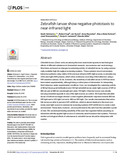Citation link:
http://dx.doi.org/10.25819/ubsi/9920Files in This Item:
| File | Description | Size | Format | |
|---|---|---|---|---|
| Zebrafish_larvae_show_negative_phototaxis.pdf | 1.1 MB | Adobe PDF |  View/Open |
| Dokument Type: | Article | metadata.dc.title: | Zebrafish larvae show negative phototaxis to near-infrared light | Authors: | Hartmann, Sarah Kunze, Jan Vogt, Roland Rauschert, Anna Kuhnert, Klaus-Dieter Wanzenböck, Josef Lamatsch, Dunja K Witte, Klaudia |
Institute: | Institut für Biologie | Free keywords: | Zebrafish, Phototaxis | Dewey Decimal Classification: | 590 Tiere (Zoologie) | GHBS-Clases: | VOA VQS VSC |
Issue Date: | 2018 | Publish Date: | 2021 | Source: | PLoS ONE ; 13 (11), e0207264. - https://doi.org/10.1371/journal.pone.0207264 | Abstract: | Zebrafish larvae (Danio rerio) are among the most used model species to test biological effects of different substances in biomedical research, neuroscience and ecotoxicology. Most tests are based on changes in swimming activity of zebrafish larvae by using commercially available high-throughput screening systems. These systems record and analyse behaviour patterns using visible (VIS) and near-infrared (NIR) light sources, to simulate day (VIS) and night (NIR) phases, which allow continuous recording of the behaviour using a NIR sensitive camera. So far, however, the sensitivity of zebrafish larvae to NIR has never been tested experimentally, although being a critical piece of information for interpreting their behaviour under experimental conditions. Here, we investigated the swimming activity of 96 hpf (hours post fertilization) and 120 hpf zebrafish larvae under light sources of NIR at 860 nm and at 960 nm wavelength and under VIS light. A thermal source was simultaneously presented opposite to one of the light sources as control. We found that zebrafish larvae of both larval stages showed a clear negative phototactic response towards 860 nm NIR light and to VIS light, but not to 960 nm NIR light. Our results demonstrated that zebrafish larvae are able to perceive NIR at 860 nm, which is almost identical to the most commonly used light source in commercial screening systems (NIR at 850 nm) to create a dark environment. These tests, however, are not performed in the dark from the zebrafish´s point of view. We recommend testing sensitivity of the used test organism before assuming no interaction with the applied light source of commonly used biosensor test systems. Previous studies on biological effects of substances to zebrafish larvae should be interpreted with caution. |
Description: | Finanziert aus dem DFG-geförderten Open-Access-Publikationsfonds der Universität Siegen für Zeitschriftenartikel |
DOI: | http://dx.doi.org/10.25819/ubsi/9920 | URN: | urn:nbn:de:hbz:467-19090 | URI: | https://dspace.ub.uni-siegen.de/handle/ubsi/1909 |
| Appears in Collections: | Geförderte Open-Access-Publikationen |
This item is protected by original copyright |
Page view(s)
427
checked on Dec 25, 2024
Download(s)
58
checked on Dec 25, 2024
Google ScholarTM
Check
Altmetric
Items in DSpace are protected by copyright, with all rights reserved, unless otherwise indicated.

